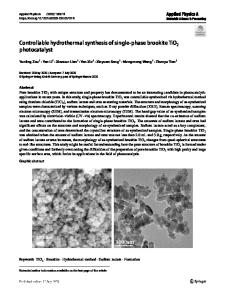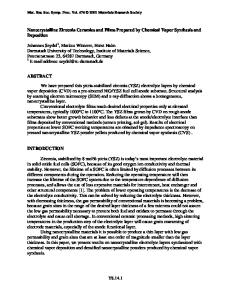Chemical Synthesis of Single and Mixed Phase Oxide Ceramics
- PDF / 3,409,926 Bytes
- 12 Pages / 414.72 x 648 pts Page_size
- 4 Downloads / 724 Views
CHEMICAL SYNTHESIS OF SINGLE AND MIXED PHASE OXIDE CERAMICS K. S. MAZDIYASNI Air Force Wright Aeronautical Laboratories Wright-Patterson Air Force Base, Ohio 45433
USA
ABSTRACT Thermal and hydrolytic decomposition of metal alkoxides, M(OR)n, is employed to obtain ultra-high-purity submicron-size < 50 nm refractory, ferroelectric, and electro-optic oxide powders. The high surface activity associated with these powders makes possible relatively low temperature processing of the powder compacts to near theoretical density with uniform fine-grain-size bodies. Transmission electron microscopy, high-temperature X-ray, and infrared and Raman spectroscopy are used to observe nucleation, growth, crystallite morphology of the synthesized powder, and microstructural features. INTRODUCTION High-purity submicron-size particulate refractory boride, carbide, nitride, and oxide powders have received much attention during the past two In part, this intensive effort has been prompted by new applicadecades. tions for these compounds in the synthesis of high-density refractory, nuclear, electronic, laser, and optical bodies, thin-film electronic components, fibers, fillers for ablative and other composite structures, catalysts and catalyst carriers, phosphors, propellant additives, and adsorbent materials. Also, advances in technology, instrumentation, and data interpretation have contributed much to the understanding of fine-particulate technology as a whole. In the classical method of preparing fine-particulate oxides, salts such as the oxalates, acetates, and carbonates are thermally decomposed to the oxides [1]. Hydroxides have also been commonly employed [2]. The hydrolysis of compounds such as metal chlorides is another convenient method which has received recent study in the vapor-phase reaction of metal halides with steam [3]. Relatively novel methods such as freeze-drying, the plasma arc with induction coupling [4], and the Vitro electric arc process [5] have been used While each because of the current interest in high-purity particulates. approach has definite merits, none of the aforementioned methods has achieved consistent results in producing refractory oxides in both high purity and submicron powder size. The newer techniques do not achieve higher purities than classical thermal decomposition and precipitation methods, although particle size may consistently be 100 nm or less. Specifically selected "tailor-made" metal organic compounds can be made which will thermally or hydrolytically decompose to form familiar inorganic nonmetallic materials such as the refractory, ferroelectric, piezoelectric, This approach to high-purity fine particuand electro-optic oxides [6]. lates, 3-150 nm, offers almost unlimited flexibility because of the wide variety of organic compounds that have become available in recent years. Unique processes described here invariably result in ceramic powders and bodies with improved thermophysical and thermomechanical properties over conventional ceramics. Mat. Res.
Soc.
Syp. Proc. Vol.
32
(1984
Data Loading...









